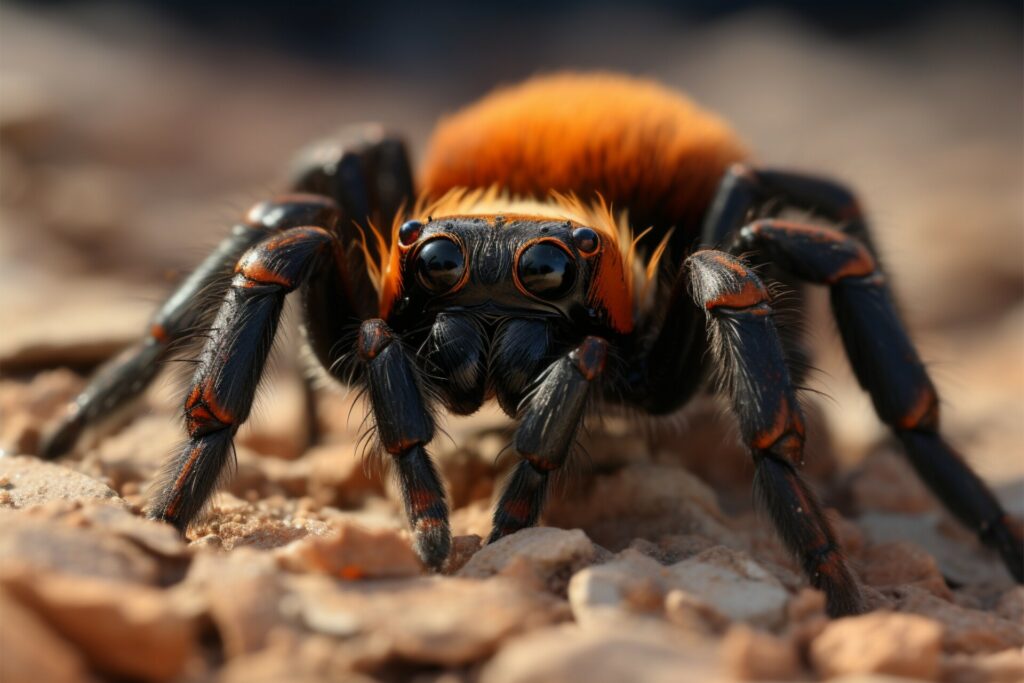How are Tarantulas Different from Other Spiders?
Tarantulas often catch people’s attention due to their large size and hairy appearance. While they share many traits with other spiders, tarantulas also have distinctive characteristics that set them apart. Understanding these differences can help in better appreciating and managing spider control around your home. In this blog post, we will discuss how tarantulas differ from other spiders in terms of size, habitat, behavior, and more.

Tarantula Size and Appearance
Size
One key difference between tarantulas and other spiders is their size. Tarantulas are some of the largest, with leg spans up to 12 inches and weights over 3 ounces. In contrast, most spiders, like the average house spider, have a leg span of only a few centimeters.
Hairy Bodies
Tarantulas are known for their hairy bodies. Their hairs, called setae, help them sense vibrations and deter predators. Other spiders also have hair, but it’s less prominent and functional than in tarantulas.
Habitat and Distribution
Preferred Environments
Tarantulas thrive in warm climates, often in tropical, subtropical, and desert areas, living in burrows or under rocks and logs. Other spiders are more adaptable, inhabiting diverse environments like homes, gardens, forests, and even underwater.
Geographic Distribution
Tarantulas are mainly found in the Americas, Africa, and some parts of Asia, but are rarer in Europe and Australia. In contrast, other spiders can be found globally and thrive in nearly any region.
Behavior and Lifestyle
Hunting Techniques
Tarantulas are ambush predators, waiting at their burrow entrances to strike prey. Unlike many spiders, they don’t use webs to catch prey, but instead use their strong fangs and venom. Other spiders mainly hunt with webs.
Molting Process
Tarantulas shed their exoskeleton through molting to grow, a process that can take several hours. Other spiders also molt, but their process is usually quicker and simpler.
Lifespan
Tarantulas generally live longer than other spiders. Females can reach up to 30 years, whereas males usually live around 10 years. In contrast, most spiders live just a few months to a couple of years.
Reproduction
Mating Rituals
Tarantulas have a unique mating process. Males use complex rituals, like leg drumming and intricate movements, to attract females for successful mating. These rituals are generally more elaborate than those of other spiders.
Egg Sac Care
Female tarantulas are known for protecting their egg sacs, guarding them until the spiderlings hatch, which can take weeks. Some tarantulas even carry the sac with them, unlike other spiders that may leave their egg sacs unattended.
Spider Control Considerations
Managing Tarantulas
In terms of spider control, managing tarantulas can be different from handling other spiders. Due to their size and habitat preferences, simple measures like removing webs may not be effective. It is important to seal cracks and crevices in your home and maintain clean, clutter-free spaces to reduce the likelihood of tarantulas taking up residence.
General Spider Control Tips
For general spider control, regular cleaning and decluttering are key. Removing potential hiding spots and using natural repellents can help keep spiders at bay. Additionally, ensuring that window screens and door seals are intact will prevent spiders from entering your home.
Creating a Spider-Free Home: Expert Tips and Solutions
Tarantulas are unique among spiders for their large size, hairy bodies, and distinct hunting methods. Although they might look intimidating, understanding them can improve spider control. Preventing spiders from entering your home ensures a safer, more comfortable environment. Proper control is crucial, whether for tarantulas or other spiders.
Interested in making your home a no-go zone for tarantulas and other spider species? Rock Pest Control is here to help. With our expert team dedicated to effective spider control techniques, we ensure your living space remains comfortable and spider-free. Contact Rock Pest Control today for a safer, more secure environment where you can relax without worry.
